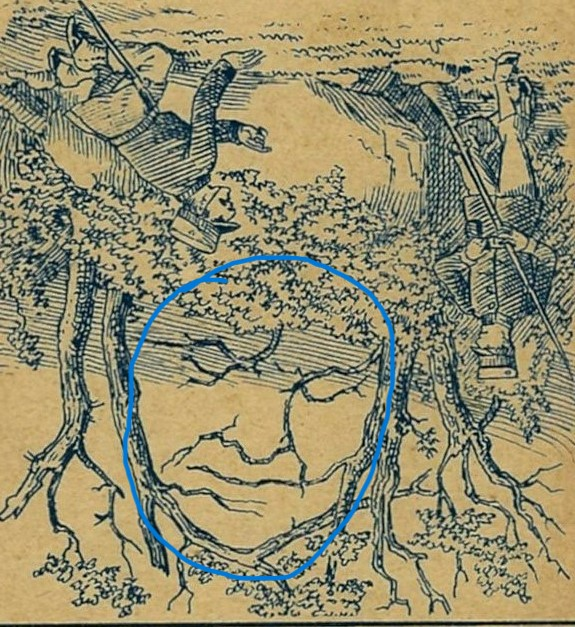Uncovering the Hidden Lookout: A Soldier’s Reconnaissance in the Forest
A Glimpse into Covert Operations
Imagine you’re stepping quietly through dense underbrush, heart pounding as every twig snap echoes like a gunshot. That’s the world captured in this century-old sketch: a vigilant soldier standing guard while his comrade presses close to the ground, peering into a shadowy hollow. It’s not just a drawing—it’s a window into the art of military reconnaissance, where every leaf could conceal danger, and every moment holds the promise of discovery.

Historical Context of Trench and Forest Warfare
When we think of trench warfare, images of muddy trenches and barbed wire often come to mind. But long before elaborate trench networks dominated battlefields, soldiers relied on natural cover—woods, hills, and ravines—to shield themselves from enemy fire. In this scene, likely set during the Franco-Prussian War or an early 20th-century conflict, two infantrymen use trees and shrubs as their fortress. It’s a reminder that soldiers throughout history adapted to their terrain, whether carving out foxholes or disappearing into thickets.
The Role of the Sentry in Early Reconnaissance
The soldier on his feet, rifle at rest but senses on high alert, embodies the classic sentry. His primary job? To stand guard, protect his squad, and call the alarm at the first hint of movement. Sentries were the eyes and ears of an encampment—vigilant, unwavering, and ready to raise the alarm. In many ways, they were the first line of defense, ensuring that no lurking enemy could slip through the shadows unnoticed.
Crawling Tactics: Eyes on the Ground
Meanwhile, his kneeling comrade demonstrates another essential skill: low-crawl reconnaissance. By staying close to the earth, soldiers minimized their silhouettes, blending into natural contours. This method let them inspect suspicious hollows, underground dugouts, or enemy listening posts without revealing their presence. Think of it like a cat burglar inching along a fence—silent, deliberate, and always alert to unseen hazards.

Camouflage and Concealment: Nature’s Armor
Have you ever noticed how a fallen trunk or a cluster of ferns can hide you in plain sight? Camouflage isn’t a modern invention. Our sketch hints at how 19th-century soldiers draped themselves in netting or earth to break up their outlines. By mimicking leaves, bark, and shadows, they tricked the enemy’s eyes. It’s like playing hide-and-seek—but the stakes are infinitely higher.
Tools of the Trade: From Rifles to Field Glasses
In the soldier’s hands rests a simple rifle, but just out of frame, field glasses or a pocket compass might be tucked away. Early reconnaissance units often carried minimal gear: a weapon, a water flask, and navigational tools. Every additional item slowed them down and risked noise. Their focus was speed, stealth, and observation. After all, one well-placed warning could save dozens of lives in the rear.

Risk and Reward: The Tension of Discovery
Reconnaissance is a balancing act between danger and necessity. If you’re too bold, you risk exposing your position; too timid, and you miss critical intel—like an enemy ambush or hidden supply cache. In the image, the tension is palpable: will the kneeling soldier signal “all clear,” or will his hand freeze mid-gesture as an enemy patrol emerges? That moment of suspense encapsulates why commanders valued skilled scouts above almost any other asset.
Lessons for Modern Military and Civilian Applications
You might wonder, “What can we learn today from this faded illustration?” Plenty. Modern soldiers still rely on cover, low-crawl techniques, and alert sentries—though now they pair these skills with night-vision goggles and GPS. Even outside the military, first responders and search-and-rescue teams borrow these tactics when navigating collapsed buildings or dense forests. The principle remains: observe carefully, move deliberately, and never underestimate the power of natural concealment.

Training the Next Generation of Scouts
These days, specialized reconnaissance units undergo rigorous training—learning advanced camouflage, drones, and satellite imagery analysis. Yet at the core lies that same, timeless skill: using your eyes and ears to gather information. Just as our two soldiers practiced silent approaches and undetected observation, modern scouts refine those basics before adding high-tech layers. It’s a powerful reminder that while tools evolve, human ingenuity remains the cornerstone of successful reconnaissance.
Mindful Observation Beyond the Battlefield
Here’s a thought: what if we applied “reconnaissance” to everyday life? Think of a new neighborhood you’re exploring—notice unusual signage, safety hazards, or hidden community gardens tucked behind fences. Like our soldiers, you can move mindfully through your surroundings, spotting details others might miss. Whether you’re birdwatching, urban exploring, or simply hiking, embracing a recon mindset makes you more aware, curious, and connected to the world around you.

Conclusion: The Timeless Value of Reconnaissance
This evocative sketch of soldiers in a forest clearing isn’t just a relic—it’s a masterclass in reconnaissance, camouflage, and the human drive to uncover what lies beneath. From the steadfast sentry to the crouched observer, every detail teaches us about risk, reward, and the art of seeing beyond the obvious. Whether on a historical battlefield or in modern-day adventures, the principles of careful observation, strategic movement, and respect for natural cover continue to guide explorers, soldiers, and curious minds alike. Next time you wander through the woods or scan a new environment, channel your inner scout—because discovering hidden truths never goes out of style.





